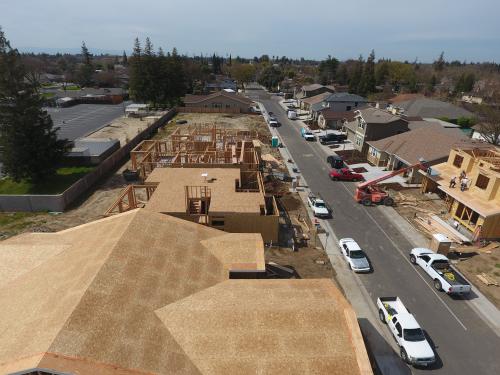Earlier this year, HUD Secretary Ben Carson raised eyebrows when he proposed changing the agency’s mission statement, removing references to “sustainable, inclusive communities.” Changes to HUD’s mission statement reflect an underlying problem. The U.S. does not have, nor has it ever had, a comprehensive vision for housing policy. Rather, many separate policies enacted by federal, state, and local government agencies affect housing markets. Only 4 percent of U.S. households (about 5 million low-income families) receive housing subsidies from the federal government. But the availability, quality, cost, and location of housing matters to all Americans.
In this article, I examine six goals that housing policy should try to achieve—and three pitfalls it should avoid. Future articles will describe current policies that impact housing outcomes and how they should be adapted to better achieve social and economic goals.
Figure 1: Do’s and don’ts of good housing policy

Goal 1: Housing should not harm the health and safety of families or communities.
In the late 19th century, progressive reformers worried about how tenement buildings endangered poor families. The lack of fresh air and running water, combined with overcrowding, encouraged the spread of contagious diseases. Policies such as minimum quality building standards are necessary to protect families and communities. Unlike in earlier eras, today’s housing quality deficiencies may not be readily observable by prospective residents. Examples include lead-based paint or asbestos, which can be particularly dangerous for children. Residents of Flint, Mich. and other localities unknowingly drank unsafe water from public utilities for years. Poorly designed or maintained buildings may also harm neighbors. For instance, fires in unsafe buildings cause devastating human and financial damage to communities.
Goal 2: Information about housing transactions should be clear, so that people and companies can make good decisions.
Many housing market activities—searching for a rental apartment, signing a lease, taking out a mortgage—are complicated legal and financial transactions. Often one party involved has more information than others. For instance, during the mid-2000s housing boom, many borrowers signed mortgage contracts they did not fully understand and could not repay. To make sure that parties do not enter into agreements that they don’t understand or that don’t reflect their true willingness to pay, public policy should require appropriate information disclosures and provide redress for deliberately withholding relevant information.
Goal 3: Housing location, construction, and maintenance should improve environmental sustainability and resilience.
To mitigate environmental impacts, public policy should encourage thoughtful placement of new housing and increased use of clean building materials and technologies. Houses are one of the primary sources of energy consumption, requiring fuel and other natural resources for construction, heating and cooling, and daily activities. Transportation systems that move families between their homes and jobs consume large amounts of energy and create greenhouse gas emissions. Housing location patterns—especially proximity to water—also affect communities’ vulnerability to the impacts of climate change.
Goal 4: Housing supply should be able to expand to meet demand.
State, regional, and national policymakers should reduce barriers to housing supply erected by local governments. Housing supply is critical to economic growth. In regions where housing is scarce or too expensive, firms will have difficulty hiring and retaining workers and young people will delay forming new households. In aggregate, the nation’s productivity will suffer. Local governments in some of the country’s most productive regions, particularly the West Coast and the Northeast, have adopted overly restrictive land use regulation that constrains housing growth and drives up prices. These policies are popular with current homeowners, but they reduce state and national economic well-being. Moreover, they systematically exclude young workers and lower-income families from living near employment centers and in communities that provide economic opportunity.
Goal 5: All families should have access to neighborhoods that offer economic opportunity.
Policymakers should reduce barriers to high-opportunity neighborhoods, both by prohibiting discrimination today and addressing longstanding wealth gaps caused by past discrimination. Where families live has important implications for their economic, physical, social, and emotional well-being. Location is particularly critical for children: The neighborhood in which they live determines what schools they attend and which children become their friends. For most of U.S. history, housing discrimination has restricted African-Americans from living in high-opportunity neighborhoods. Fifty years after the Fair Housing Act banned discrimination based on race, color, religion, sex, or national origin, most metropolitan areas still suffer from high levels of racial and economic segregation.
Goal 6: To help poor families achieve housing stability, increase their incomes.
All families need a safe, stable, healthy place to live. Housing instability and persistent financial stress harms families’ economic, physical, and emotional well-being. But the poorest 20 percent of U.S. families have too little income to afford even minimum quality housing. In most parts of the U.S., affordability problems for poor families reflect low wages and insufficient jobs, not excessively high housing costs. The most direct solution is therefore to supplement the incomes of poor families. Unless there are other indicators that local housing markets are not functioning well—for instance, excess regulation is driving up housing costs—supply-side policies are likely to introduce further distortions and will help fewer families for the same amount of money.
Pitfall 1: Don’t subsidize housing in some locations more than in others.
Policymakers should consider the impacts of programs that explicitly or implicitly favor certain types of locations. For instance, transportation policies that prioritize cars and highways over mass transit implicitly benefit suburbs and rural areas, with negative environmental impacts. Federal assistance for rebuilding homes damaged by fires or hurricanes subsidize areas prone to natural disasters and encourage future construction in those same vulnerable locations.
Pitfall 2: Don’t subsidize homeownership over renting.
U.S. tax policy provides vastly larger subsidies to homeowners than to renters. Owners can deduct interest paid on their mortgages (up to $750,000) and some local property taxes from their income subject to federal taxes. The size of these two subsidies—approximately $120 billion per year—dwarfs direct subsidies to low-income renters (around $40 billion). Academic research has debated whether homeownership creates wider social benefits: if homeowners take better care of their houses, are more engaged citizens, or are better parents. But the size of possible social benefits is nowhere near the scale of current subsidies.
Pitfall 3: Don’t subsidize real estate over other wealth-building mechanisms.
Policymakers have clear reasons for encouraging households to accumulate savings. Savings insulate households against rainy days, allow them to invest in education, and pay for retirement. Housing is the largest financial asset for most households, so homeownership has been viewed as the primary mechanism of wealth-building. But homeownership is also financially risky. By subsidizing owner-occupied housing more than other asset classes (such as stocks and bonds), current federal tax policy distorts households’ incentives to build wealth through less risky and more diversified channels.
Conclusion
In the U.S., essential housing outcomes are largely determined by the invisible hand of the market–individual families negotiating with private-sector developers, landlords, and lenders. But public policy has the potential to improve the efficiency and equity of housing markets–if policies are thoughtfully designed and implemented. Having a clear idea of what goals housing policy should achieve is a necessary first step. Subsequent articles will address what current policies do, and how they could be improved.
Thanks to Ranjitha Shivaram for excellent research assistance.
The Brookings Institution is committed to quality, independence, and impact.
We are supported by a diverse array of funders. In line with our values and policies, each Brookings publication represents the sole views of its author(s).







Commentary
Nine rules for better housing policy
May 2, 2018